Given how popular betta fish are, it’s natural for us to be curious about their breeding habits. If you’re a first-time betta keeper, it may startle (or delight!) you to notice your first betta fish bubble nest. The distinct bubble shapes are made of saliva-covered air bubbles – and if you’ve ever observed a male betta hard at work, you’ll know that these are truly a labor of love!
But what exactly are bubble nests? And what purpose do they serve in betta fish’s life cycles? This article takes a close look at precisely what bubble nests are, and how they are related to spawning. So, if you’ve ever asked yourself “Why are there bubbles in my betta fish tank?” this article is for you!
What’s A Betta Bubble Nest?
To put things in the simplest terms, a bubble nest is simply a cluster of bubbles that one might notice on the surface of a betta tank containing male fish. They measure about two to three inches in diameter, and can look pretty cool! Many of them have layers of bubbles stacked on top of one another. Another cool fact? The bubbles are all uniform in shape and size!
Why Do Bettas Make Bubble Nests?
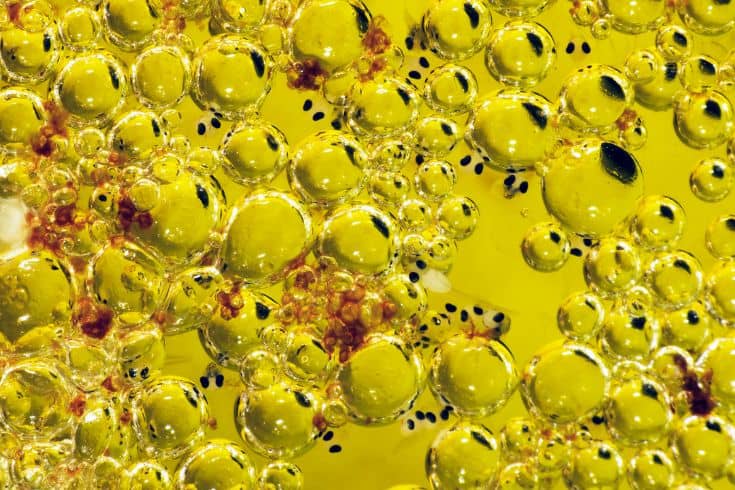
There are two key reasons why betta males make bubble nests. The first is to attract female betta fish. Yes – their gorgeous, long fins ought to have done the trick. But a big, elaborate bubble nest signals to the females that he is ready and eager to provide parental care. You see, the female will lay betta eggs in the bubble nest, and then the male will watch over them until they hatch into baby betta fish.
The second reason is that bubble nests provide shelter and protection to the eggs. When the female releases her eggs, the male will pick them up with his mouth, and place each egg within a bubble structure. Filling the bubble nest with eggs guards them against predators, because it allows the eggs to float atop the water. Eggs that stay at the bottom of the tank will be at greater risk of being eaten.
Above all, it’s important to remember that bubble nest building is just part and parcel of a male betta’s natural behavior. There is a biological urge in males to build bubble nests even when no females are present. This is why even males housed in solo tanks will sometimes make bubble nests too. Rest assured that this is perfectly normal behavior – your males are simply doing what comes naturally!
How Do Male Bettas Make Bubble Nests?
Bubble nests are essentially hundreds of tiny air bubbles stacked together in bubble clusters. Though they may look elaborate, betta bubble nest construction is pretty straightforward. To make a bubble nest, the male betta will blow bubbles with his mouth, encasing each air bubble with a thin film of sticky saliva. This creates a protective shield for each bubble.
Then, you will notice your betta blowing bubbles over and over to produce hundreds of bubbles. The bubbles are placed in what can only be described as an architecturally logical manner. There’s no specific rule for how these bubble clusters should look, but most will have a concentrated center with multiple layers of bubbles. They may be flanked by thinner, shallower layers.
The same way there’s no “right” way to build a bubble nest, there’s no “right” size for the nest either. Some nests span a significant portion of water surface, while others may be clustered around a small segment. One thing’s for sure though – it takes a ton of work and effort for the male betta to produce this elaborate architectural structure from saliva! The whole process is pretty amazing.
How To Encourage Bubble Nest Building
Previously, we’ve stated that bubble nest building is natural behavior on the part of male bettas. But if you’re not too keen on the idea of leaving things up to chance, there are a few different things you can do to encourage bubble nest building:
Stay On Top of Water Changes
You should already be doing your best to keep water parameters in check, but if you need an extra push, it may be helpful to learn that a clean tank encourages bubble nest building. That’s right – the ideal conditions for nest building are similar to the ideal conditions for betta health. So, keeping the environment clean allows you to kill two birds with one stone.
How often you change the water will depend on your particular setup. We recommend testing your water frequently to determine what works best for you. You want ammonia and nitrate levels to be as close to 0 ppm as possible. Note that a 0 ppm does not necessarily mean that there are no toxins present – they’re just undetectable. And that’s the range you want to shoot for.
Of course, even if you’re diligent about water changes, it’s still possible that your fish won’t build a nest. Ideal water conditions may encourage bettas to build bubble nests, but they do not guarantee it. Nevertheless, you should strive to provide the best environment possible for your fish, regardless of whether or not you’re dealing with a specific issue.
Introduce Floating Plants
Betta males prefer to build bubble nests underneath floating plants. It’s just a fact. And when you think about it, this makes sense. Floating plants can help keep the bubble nest safe. While this may not matter in a betta fish tank where (presumably) there aren’t any predators, bettas, like most fish, tend to behave as they would in their natural habitat.
So, if you’d like to encourage your betta males to build larger bubble nests more often, do consider adding a floating plant or two. Suitable candidates include Salvinia, Pistia, Water Lettuce (Lagarosiphon), Duckweed and Frogbit. These are easy to maintain too! Simply remove any excess growth when the plant starts to crowd out your betta’s swimming space.
Floating plants also lend a hand in creating a natural environment in your tank. This puts them at ease – increasing the odds that your betta will be more active and healthier. They also add a different texture to the tank design, making it look more attractive. In addition, floating plants also have the added benefit of increasing oxygenation in the tank, which is a plus for your bettas!
Choose the Right Filter
We all understand the importance of choosing an appropriately-sized filter. But when it comes to bubble nest building, you also want to make sure you choose an appropriate type of filter for your betta boys. What does this mean, specifically? Well, you want something that doesn’t create too many ripples on the water’s surface. Bettas know when their hard work might go to waste!
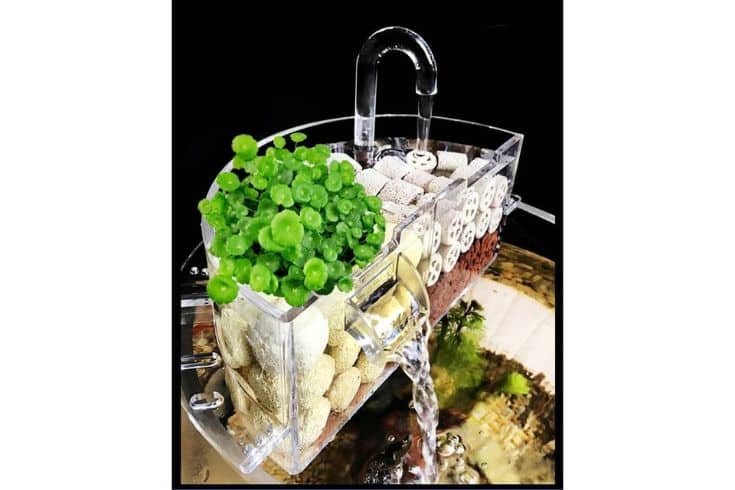
While it can be difficult to predict how much current a tank filter might produce in your tank, it’s generally safe to go with something that has an adjustable flow. Resist the urge to opt for a filter that’s stronger than what you actually need. Yes, filters do a lot of the heavy lifting in getting rid of a dirty environment, but they can also disrupt your betta’s attempts at creating a bubble nest.
Frankly speaking, opting for a gentle filter should be high on your list of priorities regardless of whether or not you plan on breeding your beautiful boys. Many bettas have long, elaborate fins. A filter that’s too strong creates drag and can even cause them to tear or break. In short, you want to look for a filter that has adjustable flow and is gentle enough not to disrupt your betta’s bubble nest.
Keep Water Temperature Well-Controlled
Remember when we stressed the importance of keeping a clean tank? Well, maintaining ideal water temperatures of between 78-82 degrees Fahrenheit is yet another thing you can do to encourage betta nest building. These are fish that are accustomed to the warm temperatures of Southeast Asia – so it’s important that you keep your tank temperatures in check.
Unless you live in a part of the world where the room temperature naturally stays in the mid-70s, you’ll need to use a heater to maintain the proper temperature. Many in the aquarium hobby recommend getting one regardless of whether or not you think you need one. Heaters don’t just heat the water, they also ensure that you maintain a specific temperature in your tank.
Both temperature stability and ideal temperature range are important for bettas to thrive and build bubble nests. Do opt for a heater that has an adjustable thermostat, and test the water temperature regularly with a thermometer. Heaters are known to malfunction and cause a spike in temperature, which can be disastrous for your betta. Best to err on the side of caution!
Place A Mirror in the Tank
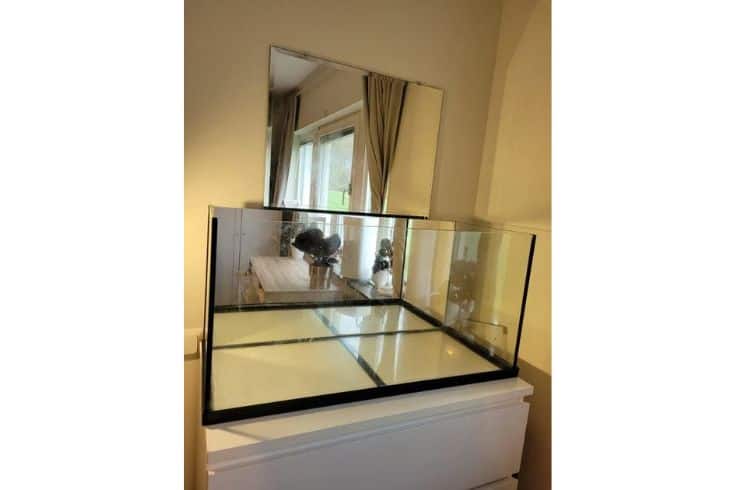
Ah, nothing like a little competition to get your betta males raring to go. A mirror in the tank encourages bubble nest building by introducing a perceived rival. This is a great way to get your betta male to show off his best behavior, including building the biggest, most elaborate nest. However, there are a few precautions you’d need to take if you intend to go this route.
First, make sure your bettas aren’t stressed out by the presence of the mirror. If they seem extra aggressive or distressed, remove the mirror right away. Individual betta temperaments play a major role in how they react to the mirror. A more aggressive, competitive male might love the chance to show off, while a timid betta might not take well to the competition.
Second, keep the mirror sessions short – no more than 5 minutes at first. Gradually increase the time as you observe how your betta reacts, and stick to a maximum of 1-2 sessions per day. You can of course adjust this schedule depending on your betta’s reaction, but do play it safe in the initial stages by limiting the mirror time. The last thing you want is to stress your precious fish out!
Nothing Can Guarantee Betta Fish Bubble Nest Building
While the tips we listed above may encourage a betta fish to build bubble nests, nothing is ever guaranteed. Whether or not your betta builds bubble nests rests mostly on biological impulse. This is a breeding-related activity after all.
The good news is whether or not a betta fish builds bubble nests is not an indication of its overall health. As long as the fish is eating, swimming, and interacting with its environment, it is likely happy and healthy. Sure, the presence of a bubble nest may serve as an indicator of a content fish, but it is not the be-all and end-all of your betta male’s health.
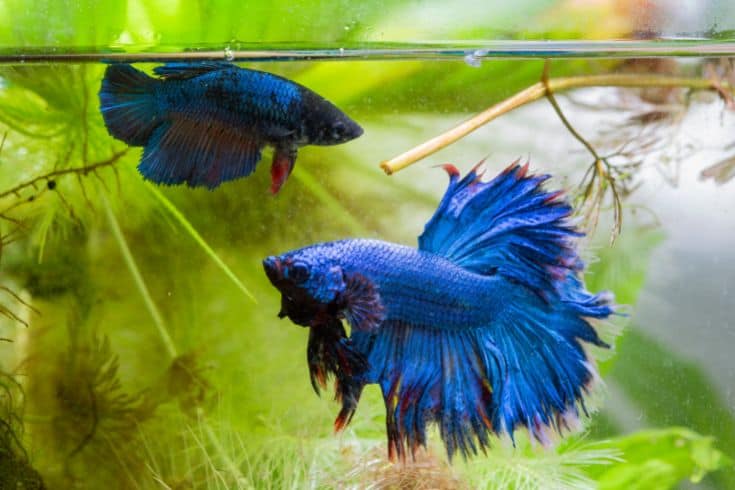
Once again, the tips we’ve listed tend to promote betta health regardless of whether or not the fish builds bubble nests. To ensure the best quality of life for your betta, make sure to keep the tank clean and the water temperature at a comfortable level. Additionally, provide your betta with a natural environment, and opt for the right filter to keep things in check. You should have a healthy betta in no time!
FAQs
Can Female Bettas Build Bubble Nests?
Bubble nests are generally built by males as part of mating behavior. However, there are anecdotal accounts by multiple fishkeepers who’ve seen their female bettas partake in this ritual! Some have even reported seeing their females drop eggs without the presence of a male, and depositing these eggs in the bubble nests they’ve built.
These anecdotes do not, in any way, mean that this is expected or even normal behavior. While there is nothing inherently wrong with a female having a bubble nest, it is very much the exception rather than the rule. The nature of betta behavior is highly individual, so it’s not uncommon to come across one whose behavior will contradict the norms. That’s what makes them fun fish to keep, after all!
However, if a female betta is displaying other abnormal behavior, such as excessive aggression or lethargy, it may be time to investigate further. Bubble nest building is not normally a sign of a serious illness, but strange behaviors may sometimes indicate that something is out of balance. Consider if you’ve made any drastic changes to your fish’s diet or environment in the weeks prior.
At What Age Do Males Build Bubble Nests?
Betta males hit sexual maturity at about three months of age, so that’s when you might begin to observe them making bubble nests. Some fry may take a little longer to mature sexually, and some adult males may not be interested in building bubble nests at all. These are all normal variations of male betta behavior, so don’t be too concerned if you don’t see bubble nests right away.
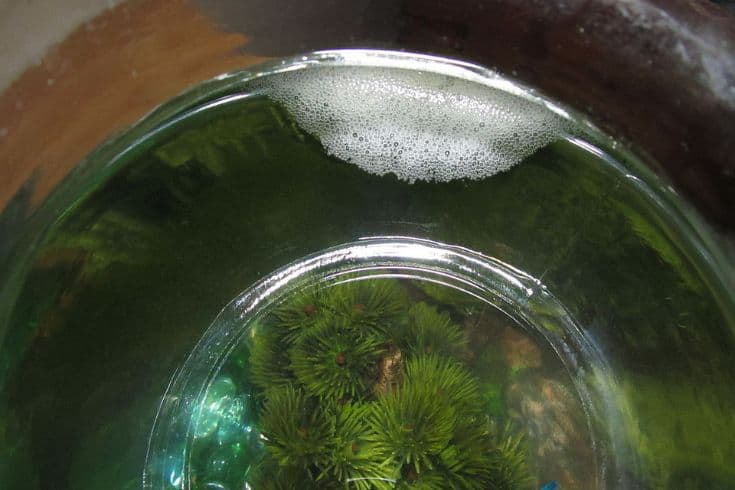
Just focus on creating the best possible environment for your fish and giving them a proper diet; the bubble nests will usually follow. Even if they don’t, he’ll still be a happy betta. Also, remember that most bettas live for up to 3 years, so they have plenty of time to build bubble nests! And if you want more info on what to expect from your betta’s growth, check out this chart!
Does the Presence of a Female Fish Encourage Bubble Nest Building?
Given that bubble nests are built as part of reproductive behavior, the presence of a female may indeed encourage your male bettas to build bubble nests. Bettas are believed to build the bubbles to create a place for the female fish’s eggs when they breed, and therefore her presence is likely seen as an invitation by males to begin nest building.
Despite the possible encouragement, you should only resort to this method if you intend to breed your fish. You should have a plan in place for the fry and be certain that the tank parameters are suitable for breeding. Whether that means selling the fish or keeping them, you need to take care of these details. Only then should you add a female betta to encourage bubble nest building!
Final Thoughts
We hope this article gave you a clearer understanding of what betta bubble nests are! While we’ve provided some tips on how to encourage bubble nest building, none of these techniques is a guarantee. However, they promote a healthier environment for your betta, and that’s what you should focus on. The rest ought to come naturally.
Did you enjoy this article? If you found it helpful, do share it with a fellow betta-enthusiast! And if you’re interested in betta breeding, check out our comprehensive guide on the subject! Thanks for reading, and good luck with your bettas!

My betta just made a bubble nest an has eggs.. can we move the nest to a bigger tank.
when should we release female after MAKING an appearance
Will my betta fish make a bubble nest if he is unhealthy or has fin rot
Very helpful
Thank you!
II have 3 males Betta ,each one in their own tank and all have been blowing the bubble nest for quite some time,I’m happy to know that they could also be happy.Every 4 days I change completely each tank and change their settings and also change their locations just mixing it up ,guess it’s working,I’ll be adding more, I dislike seeing them in the store in that little cup.it seems others also feel the same as the store turn over is fast.I appreciate your facts they help a lot.
Can I clean the bottom of the tank with the male and nest with eggs
I have seen bubble nests in my betta tank and they have always been clear. I am seeing bubbles with a brownish tint to them. I just cleaned the tank and changed the filter. Is this a problem?
No, I think brownish tints are fry.